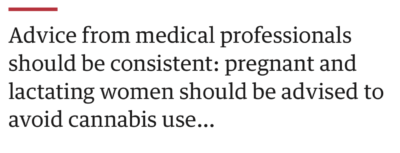“Perinatal Marijuana Use and the Developing Child” was published by JAMA as an online “Viewpoint” July 16 and will appear in the print edition in due course.* Lead author Lauren Janson is in the Department of Pediatrics at Johns Hopkins. Co-author Chloe Jordan, PhD, is with the National Institute of Drug Abuse. Their fear is that
“Expanding use of cannabis among pregnant and lactating women (as likely will occur with legalization) may lead to increased risk from fetal and child exposures if the teratogenic potential of cannabis remains underappreciated.”
Their goal —summed up in the quote highlighted by the JAMA editors— is to suppress dissent among physicians:
The authors cite every allegation of harm ever published and then express dismay that many clinicians do not consider these allegations conclusive.
… Despite these risks, it appears that clinicians are not addressing cannabis use during pregnancy or lactation; in one study of 74 lactation professionals, 85% encouraged breastfeeding among marijuana-using mothers. Most national breastfeeding guidelines (eg, the American Academy of Pediatrics and the American College of Obstetricians and Gynecologists) have remained steadfast in recommending against cannabis use during lactation. However, the Academy of Breastfeeding Medicine has changed guidelines (2009 and 2015) to allow the potential use of cannabis during lactation, citing “data…not strong enough to recommend not breastfeeding with any marijuana use” despite urging caution due to “possible long-term neurobehavioral effects.”
The medical community should advise pregnant women to avoid perinatal THC exposure and intervene for women needing treatment, for children at risk for neurobiological and developmental problems, or for dyads at risk for negative outcomes associated with an untreated substance use disorder. Advice from medical professionals should be consistent: pregnant and lactating women should be advised to avoid cannabis use, and women (and men) caring for developing children also should be advised to maintain abstinence. Treatment programs for women with CUD should be available and accessible, and gender and culturally specific, particularly during pregnancy and postpartum periods. Converging, systematic research is necessary at both the preclinical and clinical levels to address insufficient evidence regarding maternal cannabis use9 and to fully understand the short- and long-term effects of perinatal THC exposure, the effects of maternal cannabis use on fetal outcomes, and the consequences of polysubstance use in treatment and intervention efforts.
Retro Message
The JAMA authors’ pushing “treatment programs for women with CUD” reveals their neo-prohibitionist bias. Their demand for unanimity among clinicians is arrogant and unscientific, but at least it’s blatant. Behind the scenes the neoprobes are working to suppress clinical evidence that supports the use of cannabis during pregnancy and lactation.
The Society of Cannabis Clinicians’ position on this obviously important subject is being drafted by Genester Wilson-King, MD, a Florida-based Ob-Gyn, and will be shared in a Continuing Medical Education module later this year.
* JAMA sometimes turns its “Viewpoint” page over to shills for Big PhRMA. In December 2016 the SCC sent a letter of correction which JAMA published. See SCC vs FSMB in JAMA.
SCC members talked about but never sent a letter of correction after JAMA published
Read O’Shaughnessy’s line on Cannabis Use Disorder here.






